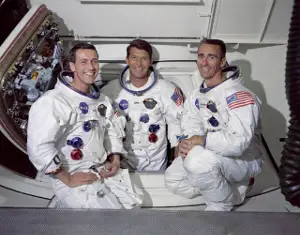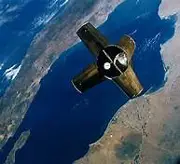Apollo 7 was the first sustained manned mission into space, launching on Oct. 11, 1968, and spending 11 days in low-earth orbit. 
It was the first manned launch since the tragic events of Apollo 1 nearly two years before. After a thorough investigation and exhaustive repairs and testing, NASA was ready to try again. The Apollo 7 mission was a test of many improvements that NASA had made since the first Apollo mission: fire-retardant spacesuits and in-capsule materials, a nitrogen-oxygen mix in the interior atmosphere, and more resilient wiring throughout. The crew of Apollo 7 featured Mercury and Gemini veteran Wally Schirra (above, center) as commander and two space rookies, Marine fighter pilot Walt Cunningham (above, right), and Air Force test pilot Donn Eisele (above, left), who had been slated for the Apollo 1 launch but had been replaced because of needing surgery. Again launching from Cape Kennedy's Launch Complex 34, the command service module (CSM), atop a Saturn I-B rocket, blasted into space on October 11. 
Still a test only of the CSM, this mission did feature a simulation of a docking with a lunar module, by Eisele. Primary among the objectives of the 11-day mission was a test of the service propulsion system (SPS), on which future crews would depend for getting the lunar module into orbit around the Moon and, of course, getting them back again. The crew tested the SPS eight times, and all were successful, including that one that resulted in splashdown, which took place on October 22 in the Atlantic Ocean. They had orbited Earth 163 times in 10 days, 20 hours. The very first time the crew fired up the SPS, it gave them a jolt and Schirra yelled out, "Yabba Dabba Doo! That's like a ride and a half!" (The reference was to the catchphrase of the TV carton character Fred Flintstone.) The Apollo CSM was a bit more spacious than had been previous craft. Also, what they ate was a definite improvement: Instead of food coming out of tube, they had freeze-dried water with which they mixed hot water to create hot food. 
The length of the mission also introduced a possible complication that missions from Project Mercury and Project Gemini did not: the possibility of sharing illness. Schirra got a cold on the first day and eventually shared it with both Cunningham and Eisele. The conditions in space interfered with their body's normal draining of fluids, and so the astronauts struggled with blocked ears and noses for much of their journey. In fact, despite express orders from the flight crew not to, the astronauts took off their helmets during re-entry because they were afraid of too much pressure on their ears. The crew also did the first live TV broadcast from space. The slow-scan television camera ran at 10 frames a second and showed black-and-white images. As always, NASA was focused on learning lessons and making improvements:
|
|
Social Studies for Kids
copyright 2002–2025
David White



 Some fuel cells on Apollo 7 overheated; scientists worked to prevent that in future launches.
Some fuel cells on Apollo 7 overheated; scientists worked to prevent that in future launches.
